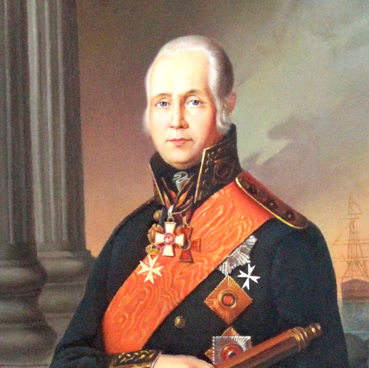This dish was presented to the Saransk Museum of Native Land on May 30th, 1920 from the Department of Public Education. It is made from an oak tree, the coat of arms of Saransk is carved in the middle. There is an inscription around the coat of arms: ‘From the citizens of the Saransk County’. The wide side is decorated with carved rims of stylized beads and four squares with symbols in the circle: Top - ‘180’, Bottom - ‘VP’, Left - ‘1810’, Right - ‘1910’, between them there is an inscription: ‘To the Vindavskiy infantry regiment. Welcome.’
According to the legend, bread was offered on this dish during the greeting of the regiment on July 23rd 1910. The Vindavskiy infantry regiment was assembled in 1811 with the creation of the Mitava provincial semi-battalion on the basis of one of the companies of the Riga garrison regiment. Mitava is now the Latvian city of Jelgava. Since then, the unit changed its composition and status several times, and in 1898 it was reorganized into the 180th infantry regiment, which was later named after the city of Vindava (now Ventspils).
In 1909, a new deployment of the Imperial army was appointed. The 45th infantry division, including the Vindava regiment, and three more regiments of the infantry and an artillery brigade, were sent from the Baltic States to the Kazan military district. The divisional headquarters were transferred to Penza, the Vindavskiy regiment - to Saransk. This city was chosen largely due to the presence of a railway station.
On July 23rd, 1910, the first units of the Vindavskiy regiment arrived from Mitava in Saransk. It was a grand event that was to revitalize the economic and cultural life of a small county town. Therefore, the arrival of the regiment was celebrated very solemnly. The military was met with bread and salt on a specially ordered for this occasion carved wooden dish. The city authorities sent congratulatory telegrams and held a feast.
In 1910, fifteen thousand people lived in Saransk, and the appearance of more than two thousand soldiers did not fit into the infrastructure of the city. This is why only the headquarters of the regiment with three companies arrived. Local authorities had to mobilize all possible housing resources of Saransk. Having repaired the soldiers’ barracks beforehand, for the resettlement of officers - the houses Kubantsev and Korotkov, which previously belonged to the city Council, the regimental office was placed in city buildings. Musicians settled down in Syromyatnikov’s house on the 2nd Uspenskaya street. Several new buildings were built: stables, forges, dining rooms, denote sheds, ammunition warehouses and the Armoury.
But all of this was a temporary measure, and, to fully billet the entire regiment, in the period between 1911 and 1914 a military town in the end of the Planskoy (now Mordovia) and 1st Uspenskaya streets (now Krasnoarmeyskaya) was built, where the lower urban pasture for cattle was situated before. The capital buildings of the Vindavskiy regiment have survived to the present day.
According to the legend, bread was offered on this dish during the greeting of the regiment on July 23rd 1910. The Vindavskiy infantry regiment was assembled in 1811 with the creation of the Mitava provincial semi-battalion on the basis of one of the companies of the Riga garrison regiment. Mitava is now the Latvian city of Jelgava. Since then, the unit changed its composition and status several times, and in 1898 it was reorganized into the 180th infantry regiment, which was later named after the city of Vindava (now Ventspils).
In 1909, a new deployment of the Imperial army was appointed. The 45th infantry division, including the Vindava regiment, and three more regiments of the infantry and an artillery brigade, were sent from the Baltic States to the Kazan military district. The divisional headquarters were transferred to Penza, the Vindavskiy regiment - to Saransk. This city was chosen largely due to the presence of a railway station.
On July 23rd, 1910, the first units of the Vindavskiy regiment arrived from Mitava in Saransk. It was a grand event that was to revitalize the economic and cultural life of a small county town. Therefore, the arrival of the regiment was celebrated very solemnly. The military was met with bread and salt on a specially ordered for this occasion carved wooden dish. The city authorities sent congratulatory telegrams and held a feast.
In 1910, fifteen thousand people lived in Saransk, and the appearance of more than two thousand soldiers did not fit into the infrastructure of the city. This is why only the headquarters of the regiment with three companies arrived. Local authorities had to mobilize all possible housing resources of Saransk. Having repaired the soldiers’ barracks beforehand, for the resettlement of officers - the houses Kubantsev and Korotkov, which previously belonged to the city Council, the regimental office was placed in city buildings. Musicians settled down in Syromyatnikov’s house on the 2nd Uspenskaya street. Several new buildings were built: stables, forges, dining rooms, denote sheds, ammunition warehouses and the Armoury.
But all of this was a temporary measure, and, to fully billet the entire regiment, in the period between 1911 and 1914 a military town in the end of the Planskoy (now Mordovia) and 1st Uspenskaya streets (now Krasnoarmeyskaya) was built, where the lower urban pasture for cattle was situated before. The capital buildings of the Vindavskiy regiment have survived to the present day.


